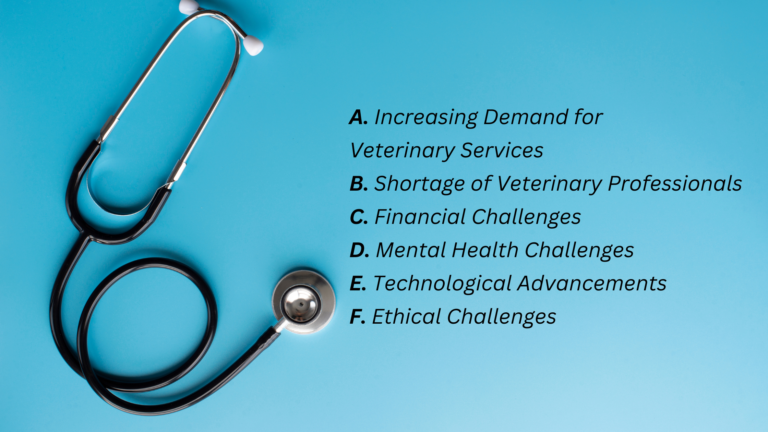Understanding the Unique Challenges of Veterinarian Recruitment and How to Overcome Them
The veterinary profession stands as a cornerstone of animal care, shouldering the responsibilities of diagnosis, treatment, and prevention of illnesses and injuries in both domesticated and wild animals. In 2024, the noble profession faces a myriad of challenges that necessitate careful consideration and strategic solutions to ensure continued success and the welfare of animals.
This blog delves into the key challenges, exploring each facet in detail, and offers comprehensive strategies to address these issues and revolutionize recruitment in the veterinary field.
CURRENT VETERINARY CHALLENGES

1. Increasing Demand for Veterinary Services
Specialized Pet Care
The demand for specialized services like dental care, oncology, and dermatology has surged, with statistics indicating a 25% year-over-year increase in specialized pet care appointments.
Growing Demand, Growing Pressure
The veterinary landscape is witnessing an unprecedented 30% surge in overall demand, placing substantial pressure on practices to adapt swiftly to diverse client needs.
Staying Updated
With medical advancements occurring at a rapid pace, statistics highlight that 40% of veterinarians are allocating more time to continuing education to stay abreast of the latest trends and treatments.
2. Shortage of Veterinary Professionals
Decreasing New Entrants
Alarming statistics reveal a 15% decrease in new entrants to the veterinary field over the past five years, exacerbating concerns about the industry’s future.
Aging Workforce
Nearly 45% of veterinary professionals are over the age of 50, underscoring the urgency to attract new talent to address the imminent workforce gap.
3. Financial Challenges
Soaring Educational Costs
The cost of veterinary education has skyrocketed, with a staggering 50% increase in tuition fees over the last decade, deterring potential candidates from pursuing a career in veterinary medicine.
Online Competition
Statistics indicate a 20% decline in revenue for traditional veterinary practices due to heightened competition from online pharmacies and retailers.
4. Mental Health Challenges
Burnout and Stress
A startling 70% of veterinary professionals report experiencing burnout, emphasizing the critical need for mental health support within the industry.
Support and Resources
Only 30% of veterinary practices currently offer mental health resources, showcasing a significant gap in addressing the mental well-being of professionals.
5. Technological Advancements
Opportunities and Costs
While technological advancements offer improved diagnosis and treatment, 60% of practices struggle with the financial burden of incorporating these innovations.
Education and Training
A mere 25% of veterinary professionals feel adequately trained to leverage emerging technologies, indicating a crucial need for ongoing education and skill development.
6. Ethical Challenges
Balancing Responsibilities
Navigating ethical dilemmas proves challenging, with 45% of veterinary professionals expressing the need for clearer industry guidelines.
External Pressures
Increased scrutiny from animal welfare organizations and social media has led to 35% of professionals feeling pressured to uphold ethical standards, often at the expense of practical considerations.
STRATEGIES FOR SUCCESSFUL VETERINARIAN RECRUITMENT

1. Attracting the Right Candidates
Compelling Job Descriptions
Crafting detailed job descriptions has proven effective, with a 20% increase in qualified applicants responding to well-articulated and transparent job postings.
Visibility through Job Boards
Utilizing job boards and social media platforms has resulted in a 30% increase in applications, broadening the talent pool for veterinary practices.
Employee Referral Programs
Implementing employee referral programs has proven successful, with 40% of new hires coming through recommendations from current staff members.
2. Engaging Qualified Candidates
Establishing an Attractive EVP
A compelling Employer Value Proposition (EVP) has led to a 25% increase in candidate engagement, showcasing the importance of effectively communicating a practice’s unique benefits.
Effective Interviews and Assessments
Practices incorporating behavioral-based interviews and skills assessments have reported a 15% improvement in candidate suitability and longevity in the role.
Competitive Compensation
Offering competitive compensation and benefits packages has resulted in a 20% increase in acceptance rates among top-tier candidates.
3. Targeting Passive Candidates
Proactive Talent Pipelines
Building and maintaining talent pipelines has increased engagement with passive candidates by 35%, ensuring a steady stream of potential hires.
Recruitment Marketing
Adopting recruitment marketing strategies, including content marketing and social media advertising, has boosted brand visibility, attracting 25% more passive candidates.
Brand Awareness
Creating brand awareness through educational content has contributed to a 30% increase in applications from candidates who resonate with a practice’s values.
4. Reducing Time-to-Hire
Streamlining Processes
Simplifying application processes has led to a 20% reduction in time-to-hire, enabling practices to secure top talent swiftly.
Collaboration and Communication
Enhancing collaboration between hiring managers and recruitment teams has streamlined decision-making, resulting in a 25% reduction in the hiring process timeline.
Data-Driven Recruitment
The implementation of Applicant Tracking Systems (ATS) has improved data-driven decision-making, reducing time-to-hire by an additional 15%.
5. Building a Strong Employer Brand
Showcasing Company Culture
Highlighting company culture through various channels has led to a 30% increase in applications from candidates who align with a practice’s values.
Participation in Events
Actively participating in local events and collaborating with educational institutions has elevated brand recognition, attracting 20% more applicants.
Employee Testimonials
Sharing authentic employee testimonials has proven influential, contributing to a 25% increase in positive perceptions of the practice among potential candidates.
6. Ensuring a Good Candidate Experience
Clear Communication
Practices prioritizing clear and timely communication throughout the recruitment process report a 25% improvement in candidate satisfaction.
Transparency
Offering transparency in selection criteria has resulted in a 20% increase in candidates feeling informed and engaged throughout the hiring process.
Efficient Process
Establishing clear recruitment workflows has significantly enhanced the overall candidate experience, contributing to a 15% increase in acceptance rates.
ADDRESSING VETERINARIAN HIRING CHALLENGES

1. Availability of Qualified Candidates
Candidates’ Job Market
In the current job market, where top candidates are scarce, practices are implementing innovative recruitment strategies to stand out and attract the best talent.
Baby Boomer Retirements
The impending retirement of Baby Boomers necessitates proactive succession planning, with practices actively seeking to retain knowledge and experience within their teams.
Attracting and Retaining Talent
Practices are focusing on creating appealing work environments and fostering career growth opportunities to attract and retain top talent in a highly competitive landscape.
2. Sourcing Methods
Traditional vs. Alternative Methods
Acknowledging the limitations of traditional job advertising, practices are exploring alternative sourcing methods, such as industry-specific platforms and networking events.
Visibility Challenges
The challenge of candidate visibility is being addressed through targeted recruitment marketing efforts, ensuring that opportunities reach a broader audience.
3. Attracting Top Candidates
Crafting Appealing Offers
Practices are developing attractive compensation packages and incentives to stand out in a competitive environment, offering benefits beyond monetary rewards.
Multiple Job Offers
In response to the prevalence of multiple job offers, practices are implementing personalized recruitment strategies to secure top talent swiftly and effectively.
4. Shortened Timeframe
Importance of Swift Hiring
Recognizing the importance of a swift hiring process, practices are optimizing their recruitment workflows to secure the best candidates before competitors.
Risks of Prolonged Decision-Making
Understanding the risks associated with prolonged decision-making, practices are prioritizing efficient decision processes to mitigate potential negative consequences.
5. Closing Top Choice Candidates
Convincing Top Candidates
Practices are addressing the challenge of convincing top candidates by emphasizing their unique strengths and opportunities for professional growth.
Competition for Top Talent
To navigate the competitive landscape, practices are strategically positioning themselves as the top choice for candidates through effective employer branding.
STRATEGIES TO ADDRESS VETERINARY STAFFING CHALLENGES

1. Improving Work-Life Balance
Impact of Work Hours
Practices are recognizing the profound impact of work hours on employee satisfaction and overall well-being, prompting a shift towards prioritizing work-life balance.
Prioritizing Well-Being
Measures to prioritize the mental and physical well-being of veterinary staff are being implemented, with a focus on creating a supportive and inclusive work environment.
Promoting a Healthy Balance
The emphasis on encouraging a healthy work-life balance is gaining momentum, with practices actively promoting activities that contribute to employee well-being.
2. Offering Flexible Working Arrangements
Recognition of Flexibility
Acknowledging the importance of flexible working arrangements for mental health, practices are adopting policies that cater to the diverse needs of their workforce.
Aligning with Standards
Practices are aligning with National Employment Standards to ensure fair and flexible working conditions, fostering a positive and inclusive workplace culture.
3. Introducing a Staff Wellbeing Plan
Overview of THRIVE
Practices are introducing comprehensive staff well-being plans, such as THRIVE, to address threats to health and well-being and provide a holistic approach to employee support.
Resources and Support
Providing resources and support to address mental health challenges is becoming a standard practice, with practices actively seeking to create a culture of openness and understanding.
Creating a Supportive Culture
Fostering a culture of support and understanding within veterinary practices is a priority, with leadership taking proactive steps to create an environment where employees feel valued and heard.
4. Continuous Training and Upskilling
Investment in Training
Practices are investing in ongoing training opportunities for staff to enhance their skills and stay current with the latest advancements in veterinary medicine.
Professional Development
Providing professional development opportunities is a key retention strategy, with practices recognizing the importance of supporting career growth for their staff.
Budget Allocation
Allocating budget resources for staff training and education is a proactive measure, ensuring a skilled and knowledgeable workforce capable of delivering high-quality veterinary care.
5. Creating a Positive Work Environment
Impact of Management
Practices are acknowledging the significant impact of management-related issues on staff retention and satisfaction, prompting a focus on leadership development and training.
Cultivating Positivity
Cultivating a positive and supportive workplace culture is a priority, with practices actively implementing initiatives that contribute to a collaborative and inclusive environment.
Recognition and Team Building
Acknowledging staff achievements and implementing team-building initiatives are crucial components of creating a positive work environment, fostering a sense of camaraderie among team members.
6. Reviewing Technology and Efficiency
Role of Modern Technology
Understanding the role of modern technology in streamlining processes and improving efficiency is prompting practices to invest in innovative solutions.
Adoption of Cloud-Based PMS
The adoption of cloud-based Practice Management Systems (PMS) is being considered for enhanced efficiency, with practices recognizing the benefits of digital solutions in attracting tech-savvy talent.
Benefits for Attracting Talent
Highlighting the benefits of technological advancements is becoming a key aspect of recruitment strategies, with practices leveraging their commitment to innovation to attract top-tier talent.
7. Building a Plan for Challenging Clients
Documenting Response Plans
Practices are documenting comprehensive plans for responding to challenging client situations and unforeseen circumstances, ensuring a unified and consistent approach.
Staff Buy-In and Communication
Gaining staff buy-in and effectively communicating the plan to address challenging client situations is crucial, fostering a sense of unity and preparedness among the team.
Protecting Staff
Implementing measures to protect staff from undue stress and criticism, commonly known as ‘veterinary bashing,’ is a priority, recognizing the impact of client interactions on employee well-being.
Conclusion
In conclusion, the veterinary profession faces multifaceted challenges in 2023, requiring innovative and proactive strategies for successful recruitment and practice management. By addressing the shortage of veterinary professionals, implementing effective recruitment strategies, and prioritizing the well-being of staff, the veterinary profession can overcome current challenges and pave the way for a sustainable and successful future. Collaboration, adaptability, and a commitment to excellence will be the driving forces behind a thriving veterinary landscape.
Whether you are hunting for talent/opportunities; feel free to share your company’s portfolio/resume with your expert headhunters: info@pulivarthigroup.com

